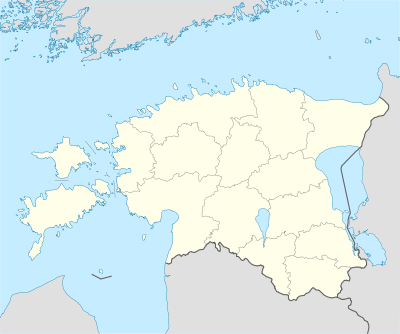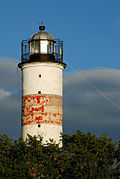Narva-Jõesuu
| Narva-Jõesuu | |||
|---|---|---|---|
| Town and municipality | |||
 | |||
| |||
 Narva-Jõesuu Location in Estonia | |||
| Coordinates: 59°27′32″N 28°02′26″E / 59.45889°N 28.04056°ECoordinates: 59°27′32″N 28°02′26″E / 59.45889°N 28.04056°E | |||
| Country |
| ||
| County |
| ||
| Government | |||
| • Mayor | Andres Noormägi | ||
| Area | |||
| • Total | 11.03 km2 (4.26 sq mi) | ||
| Population (01.01.2010) | |||
| • Total | 2,602 | ||
| • Density | 240/km2 (610/sq mi) | ||
| Time zone | EET (UTC+2) | ||
| • Summer (DST) | EEST (UTC+3) | ||
| Website | www.narva-joesuu.ee | ||
Narva-Jõesuu (German: Hungerburg, Russian: Усть-Нарва Ust'-Narva) is a town in Ida-Viru County, Estonia, located on the country's northern Baltic Sea coast near the Russian border. The name of the town in Estonian and Russian means "mouth of the Narva River".
Narva-Jõesuu has a population of 2,602 (as of 1 January 2010).[1] As in the nearby city of Narva, most residents today are Russian or Russian-speaking, although the percentage of native Estonians is slightly higher in Narva-Jõesuu (13% compared to 4% in Narva).
Narva-Jõesuu is located at the north-eastern end of the E9 European Coastal Path, which runs for 5000 km (3125 miles) from Cabo de São Vicente in Portugal.
Narva-Jõesuu flag and coat of arms were designed and approved in the mid-1990s by the chairman of the local government Pavel Grigorjev. The gold strips of land on the image symbolise Estonian and Russian coasts on both sides along the Narva River and the blue area symbolises its iconic mouth.
Tourism

Thanks to its seven-kilometre-long white sand beach lined with pine trees – one of the best in Estonia – Narva-Jõesuu has long been a popular summer destination. In the 19th century and early 20th centuries it was a spa town frequented by nobility from St. Petersburg, which is less than 150 km to the east, and during the Soviet period was visited in large numbers by residents of the renamed Leningrad, particularly the Russian intelligentsia, many of whom have bought dachas (summer houses) in Narva-Jõesuu or on the outskirts.
In the first ten to fifteen years after the restoration of Estonia's independence Narva-Jõesuu saw few visitors, with a large number of hotels and guest houses closing their doors and going out of business. In the last few years its resort facilities have been renovated and the number of tourists is rising, however the number of hotels is still considerably lower in comparison to the late 1980s.
Near Narva-Jõesuu, 2 km SW from the town border there are Narva-Jõesuu Nude Beach - the only official nude beach in Estonia.
Twinnings
 Billund Municipality, Denmark
Billund Municipality, Denmark Imatra, Finland[2]
Imatra, Finland[2] Kronstadt, Russia[2]
Kronstadt, Russia[2]
Gallery
-

Ruins of Narva-Jõesuu kuursaal (resort hall).
-
Pier in the mouth of Narva River.
-

Lighthouse
-

References
- ↑ "Population figure and composition". Statistics Estonia. Retrieved 24 May 2010.
- ↑ 2.0 2.1 "Sõpruslinnad" (in Estonian). Narva-Jõesuu. Retrieved 24 May 2010.
External links
| Wikimedia Commons has media related to Narva-Jõesuu. |
| Wikivoyage has a travel guide for Narva-Jõesuu. |
- Official website (Estonian) (Russian) (English) (Finnish)
- Narva-Jõesuu Nude Beach
| |||||||||||||
| ||||||||||||


